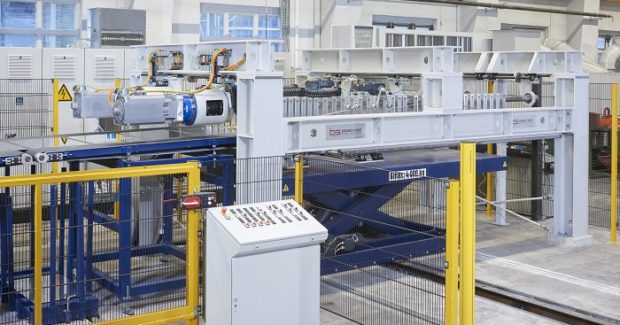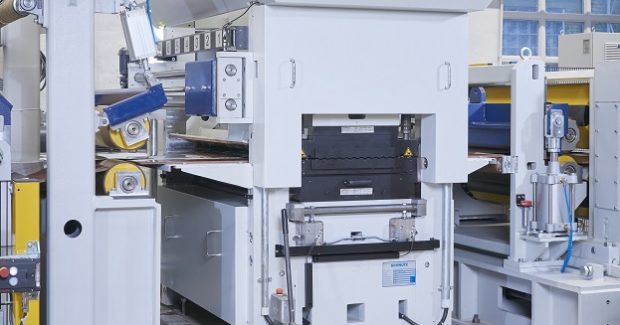Leveling the Playing Field
This custom-built aluminum cut-to-length line from Burghardt+Schmidt guarantees leveling quality for evenness, narrow tolerances, high surface quality and fewer rejects so that Martinrea Honsel Germany can optimize their light metal plate and strip production.
Posted: April 11, 2018
Martinrea Honsel Germany GmbH (Meschede, Germany) is known for fabricating aluminum plates and aluminum strips with outstanding mechanical properties, surface qualities and narrow tolerances. To satisfy rising demands of the industry, they replaced their outdated cut-to-length line in late 2017 and commissioned Burghardt + Schmidt GmbH (Remchingen, Germany) to build a tailor-made cut-to-length line using a leveler from Schnutz GmbH (Siegen, Germany) that guarantees leveling quality according to DIN EN 485-4 for surface critical processing, satisfies requirements for evenness according to DIN EN ISO 9445, and ensures 97 percent availability through reduced time for maintenance and accelerated operating speeds.
“The range of products manufactured at our plant extends from coils and sheets to stamped blanks for trim parts in the automotive industry or sheet-formed parts to decorate automobile interiors, to name just a few,” says Thomas Rünker, an engineer and project manager at Martinrea Honsel Germany. “The maintenance requirements for our previous system were rising continuously, and the procurement of spare parts was becoming increasingly difficult by the day.” System availability with the old line was no longer guaranteed. It had become necessary to maintain the old system in painstaking, increasingly short intervals to continue ensuring high production quality, and in emergencies it had become necessary to contract outside shops with cut-to-length services.
CUSTOM SYSTEM INTEGRATION GUARANTEES EVENNESS
Cold-rolled wrought aluminum alloys are cut to length in the Martinrea Honsel plant in Meschede. These anodized and non-anodized aluminum strips are destined for the automotive, furniture and suitcase industries, and a key quality requirement is the production of particularly even aluminum strips that guarantee trouble-free downstream processing. An unwinder is used to remove the strips from the coil and feed them into a leveler that uses 23 leveling rolls to ensure absolute evenness. A working width of 300 mm to 1,250 mm is required, as well as a cut length of 300 mm to 3,500 mm. The strip thickness is between 0.3 mm and 2.2 mm. The new cut-to-length line must also meet the length and form tolerances according to DIN EN 485 for aluminum and aluminum alloy strips, sheets and plates. This line is designed for up to 40 cuts per minute. “We manufacture each of these lines as a custom system to meet the conditions and specifications on site,” explains Thomas Baral, the managing director of Burghardt + Schmidt GmbH. “This system only needs slight technical modifications to handle steel and stainless steel, as well as other metals.”
QUICK CHANGE CASSETTES IMPROVE MACHINE AVAILABILITY
“It’s our experience that the leveling unit defines the quality of each individual system,” notes Rünker. “Good, reliable and regular maintenance of the leveling cassettes is essential to satisfy our production requirements. It is the only dependable way to avoid downtime.” The leveling tools must be reworked from time to time, and Schnutz (a subsidiary of Burghardt + Schmidt) handles this rework as part of their after-sale service from their factory in Siegen to guarantee continuous quality and extremely short delivery times if the leveling cassettes need to be completely replaced. Quick-change leveling cassettes were developed to reduce the time spent on inspection and replacement, minimize downtime and improve machine availability. “These leveling cassettes improve accessibility so that maintenance can be reduced,” notes Baral. “During maintenance, the operator removes the cassette completely from the leveler and positions it on a rack that is enclosed on a robust welded steel frame. The cassettes are then picked up with lifting gear, inspected and reworked if necessary.”
DRUM SHEARS ACCELERATE OPERATING PROCESS
Once the strip has been unwound and leveled, it is then cut crosswise into metal plates. “We equipped the system with a drum shear to speed up the operating process,” reports Baral. “The advantage is that the material runs continuously so that a looping pit is not needed.” This not only makes the system more compact, it also reduces the cost of the footings. Setting the blade clearance for the drum shear is fully automatic. The clearance between the two blades is adjusted automatically depending on the material strength and thickness. Material data are entered at the main operating console and the drum shear adjusts to the right clearance to prevent unnecessary user errors and speed up the operating process.
“Quick and individual adjustment for varying material properties has many benefits,” states Rünker. “It cuts tooling times and the cost of auxiliary process times, and it allows quick intervention during production in case of any deviation from the quality standard. Corrections can be initiated immediately. It also extends cutting tool life significantly.” The modern electronics in the drum shear and B+S proprietary software guarantee the narrow length tolerances that are requested by Martinrea Honsel.
SWING ARM STACKING MACHINE PROTECTS THE PRODUCT SURFACE
Once cut, the metal plates must be stacked to ensure smooth downstream processing. But this can damage the surfaces if the plates are deposited improperly. “Our workpieces must satisfy strict decorative standards, so an impeccable surface is essential,” explains Rünker. “They cannot be scratched during stacking, and the edges must be absolutely flush.” To meet this requirement, the system is equipped with a swing arm machine that stacks the sheets up to a height of 750 mm (including pallet) without damaging their surfaces. The stacker has special swing arms with powered transport rollers for moving the sheets. Highly dynamic, three-phase servomotors with controlled force-velocity curve are used for extremely precise swivel, deposit and swing movements. “In earlier iterations, these movements were powered pneumatically, but air is an extremely expensive medium,” says Baral, as he explains the motorization. “So now we use energy-efficient servomotors.”
PUNCTUAL DELIVERY & QUICK COMMISSIONING
Each of the system’s manufacturing stages was completed on schedule and Burghardt + Schmidt delivered the turnkey cut-to-length system with protective fencing to the Meschede plant in early November. The system launched production in January. “Although we rescheduled the delivery date, they still helped us with a punctual delivery and, in doing so, quickly replaced the systems in our rolling mill,” recalls Rünker. “We are confident that the improved quality off our new machine will benefit customers.”
Martinrea Honsel Germany GmbH, Fritz-Honsel-Straße 30, Meschede, Germany 59872, +49 291 291-0, Fax: +49 291 291-366, alu@martinrea.com, www.martinrea-honsel.com.
Burghardt + Schmidt GmbH, Raiffeisenstrasse 24, Remchingen, Germany 75196, +49 (0)7232 3661-0, Fax: +49 (0)7232 3661-65, info@b-s-germany.de, www.b-s-germany.de.
Schnutz GmbH, Siegstraße 75, Siegen, Germany 57076, +49 271 250620, schnutz.com.








